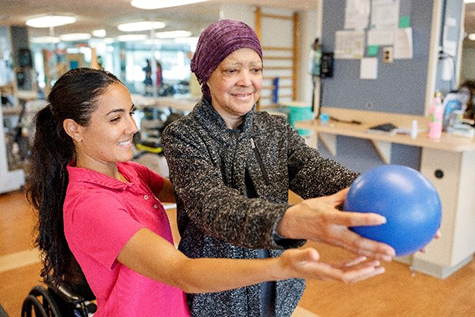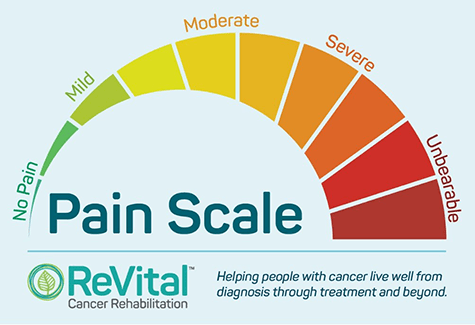Pain management through cancer rehabilitation
Posted on 10/4/2023 | 4 min. read
Finding relief from pain after cancer treatment
Many patients who are newly diagnosed find themselves asking the question, ‘Is cancer painful?’.
It’s important to note that pain from cancer and its treatments is common. In fact, 30 to 60% of patients with cancer report pain during or after treatment.
While pain can arise from cancer itself, typically from the tumor applying pressure to bones or organs, the more common form of pain is a side effect of treatment.
Pain that is caused by cancer itself is not the same as pain resulting from treatments. This distinction is worth noting as finding relief from these different types of pain can vary.
Individuals with cancer may also face worsened symptoms of pre-existing conditions, such as arthritis flare-ups during treatment.
Depending on the cause, pain can improve with time, but sometimes it lingers. Some cancer survivors describe lasting, chronic pain for months or years after treatment.
This is where a long-term treatment plan can dramatically improve a patient’s quality of life.
How does pain affect patients with cancer?
Chronic pain can impact quality of life and potentially make it harder to complete daily activities. Activities such as bathing, shopping, cooking, sleeping, working or parenting can become a challenge for patients dealing with cancer-related pain.
Pain after cancer treatment can certainly become debilitating, but this does not have to be your new normal.
If pain is interfering with your daily activities, notify your health care provider immediately.
What makes cancer painful?
The experience of pain from cancer can vary from person to person.
Your team, including a cancer rehabilitation clinician, can help determine what type of pain you are having and create a pain management plan tailored to you.
Some examples of the type of pain a cancer patient may experience include:
- Post-operative pain – After surgery, you may feel discomfort over the parts of the body affected by the incision site or the surrounding area. Post-operative pain can be the result of inflammation and scarring.
- Joint pain – Joint pain is an achy, sore feeling in the joints and surrounding muscles. If you are suffering from cancer-related joint pain, you may have difficulty moving the affected area. This discomfort can be caused by certain types of chemotherapy or hormonal drugs used in cancer treatment.
- Skin sensitivity – You may experience pain, tenderness or burning sensations of the skin. Most commonly this is seen as a result of radiation therapy.
- Peripheral neuropathy – Nerve pain can feel like sharp, shooting pain or numbness, tingling, burning or even weakness. Typically, this is caused by certain types of chemotherapy.
Finding relief from cancer with pain management
Partnering with a care team that specializes in cancer rehabilitation services can help you find relief from pain.
Rehabilitation professionals, specializing in physical, occupational and speech therapy, can help develop a cancer pain management program tailored specifically to you. This would include therapeutic exercise and movement to help decrease pain and increase overall well-being and quality of life.
ReVital Cancer Rehabilitation certified therapists will complete an evaluation and develop a tailored plan designed to help decrease pain and improve your strength, endurance and overall well-being.
Our goal is to help you get back to doing what matters most.
Start a conversation with your health care team
Don’t let your pain go untreated. If you are dealing with pain during cancer treatment, it’s important to speak with your health care provider.
When starting a conversation with your care team, be specific. Details allow them to best understand your situation and create the ideal pain management plan for you.
When describing your pain to your care team, consider the following:
- How bad is your cancer-related pain? (0-10)
- Where does it hurt?
- When did the pain begin?
- When are you in pain?
- Does this feel like new pain (after cancer diagnosis) or from before diagnosis and either stayed same or got worse?
- How long does the pain typically last?
- What does your pain feel like (achy, burning, tingling or sharp pain)?
- What can you not do when you are in pain?
- What activities cause the pain to be worse or better (for example, doing laundry may make your low back pain worse)?
Our ReVital Cancer Rehabilitation specialists recommend starting a diary/journal to track your pain and note any important details. This will help you and your cancer rehabilitation care team identify patterns that may be contributing to your pain.
Take the first step
ReVital Cancer Rehabilitation’s therapists are specially trained to identify and prescribe effective treatment plans for cancer-related pain management.
No matter where you are on your cancer journey, a comprehensive rehabilitation program can help.
Learn more about ReVital Cancer Rehabilitation and how our therapists can help you do what matters most.



